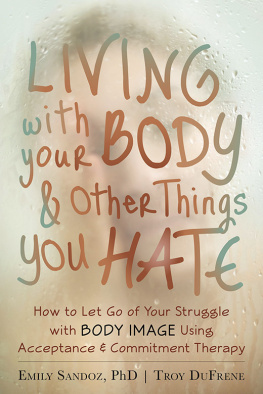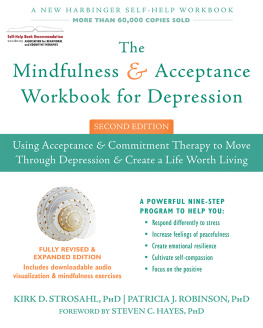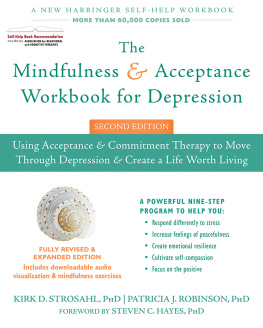Emily K. Sandoz, PhD, is assistant professor of psychology at University of Louisiana at Lafayette and coauthor of Acceptance and Commitment Therapy for Eating Disorders. She is a clinical psychologist and behavior analyst who specializes in treating clients using acceptance and commitment therapy. She lives and works in Lafayette, LA.
Kelly G. Wilson, PhD, is associate professor of psychology at the University of Mississippi. He is coauthor of Acceptance and Commitment Therapy, Mindfulness for Two, Things Might Go Terribly, Horribly Wrong, and Acceptance and Commitment Therapy for Eating Disorders. He is a popular trainer and speaker in the areas of acceptance and commitment therapy and behavior analysis, with a busy schedule of national and international engagements. Wilson lives and works in Oxford, MS. www.onelifellc.com.
Troy DuFrene is a writer in the San Francisco Bay Area who specializes in psychology. He is coauthor of Coping with OCD, Mindfulness for Two, Things Might Go Terribly, Horribly Wrong, and Acceptance and Commitment Therapy for Eating Disorders. www.troydufrene.com
1. Some Things You Should Know About How We Eat and How We See Ourselves
As youve probably noticed, the struggle weve talked about in this book isnt just disordered eating. Some folks struggle by pulling the covers up over their heads, some folks struggle by limiting the places they go, and some folks struggle by eating a certain way. So there will be times when the things we ask you to think about or try out are really general and would apply to most people. There are other times when we focus on the topic of this booka struggle some folks call bulimia.
What Is Bulimia?
You might be thinking its a little strange for us to have quotation marks around a diagnosis. The doctor doesnt sit you down in his office to tell you that you have cancer. He tells you the name, then he tells you what your body is doing thats causing you problems. Psychological problems are a little different, though. When we say psychology, were referring to the science of behavior. (Just to be clear: this isnt exactly what everyone means when they say psychology. But we come from a tradition of behavioral science, and when we say psychology, thats what we mean specifically.) Behavior is anything a person does. People come into therapy because they keep doing things that are causing them problems. Whether the behavior that brings them in consists of the way theyre feeling, the way theyre thinking, or the actions theyre taking, something theyre doing just isnt working. Our diagnoses dont explain whats going on underneath the problems people show up with, they simply describe what those problematic behaviors look like.
What Bulimia Looks Like
Bulimia (or bulimia nervosa) is a name for a particular category of problematic behaviors. When doctors and other providers say bulimia, theyre referring to three main behaviors: binge eating, compensatory behaviors, and body image difficulties. Now, you might have some idea of what each of these means (or you might be thinking, What language is this?), but were going to go ahead and describe what these terms mean to the providers who use them.
Binge Eating
The first term, binge eating, means eating more food than most people would eat in a similar situation, along with a feeling that you lack control over this eating. This is from the current technical definition. Many have noted, however, that it doesnt seem to be the amount of food thats important. A binge might be better defined as any time you eat what, for you, seems like an abnormal amount of food. If you have a very rigid diet and rarely eat meats, dairy, or white bread, then eating three pieces of pepperoni pizza might be as much of a binge as three whole pizzas for the person who eats pizza regularly. Psychologists who do research on how bulimia looks and how we should best think about these categories have suggested that the more important part may be the lack of control that comes with a binge. It may not matter if its three bites of pizza, three slices, or three whole pies. If it feels like you ate way more than you intended, it may be accurate to call it a binge.
Practice: Reflecting on Binge Eating (guided meditation)
We invite you to pause for a moment now and consider what binge eating looks like for you. We dont expect this to be easy, but we do ask you not to rush through this practice or skip to the next piece. We often do whatever we can to push difficult things like this out of our minds. We hide our behaviors from others, and we try to forget that they happen. This is part of what keeps us stuck.
You can read through the instructions to this practice first, get a feel for them, then set the book down to do the work. Or you can do the practice along with the first guided meditation on the CD (or the download, if you bought the e-book), titled Reflecting on Bulimia. Note: The audio that accompanies this book was recorded spontaneously, and although it is similar to the text in the book, it doesnt follow the text exactly, so you may not want to read and listen at the same time.
- Take a slow, deep breath. Close your eyes, and call to mind a specific time when you felt a real lack of control over your eating. Maybe you were completely unaware of what was going on while you were eating, then suddenly realized that youd eaten way more than you intended. Call up this memory from the moment just before you started to eat, and watch yourself. See if you can stay with the memory long enough to let that experience rise up fully inside you. And breathe.
- When you find yourself turning away from you and your experience, take a slow, deep breath and turn back. When you find yourself rushing through the memory, trying to get it over with, take a slow, deep breath and turn back to the beginning. Dont you deserve to be seen, even in your weakest moments?
- When youve settled into this specific memory, let yourself consider your pattern of binge eating over time. Are there certain forbidden foods you tend to binge on? Are there certain situations in which you tend to binge eat? Do you tend to binge eat in a certain place? During certain times of day? Are you more likely to binge eat after a certain kind of experience? When youre feeling a certain way? What is it like for you during a binge? After?
- Take a moment now and let yourself see clearly the details that seem important about what is going on for you before, during, and after a binge. And breathe.
- When youre ready, let your eyes slowly open.
If youre using the paper book, take a few moments and write about your reflections in the space below. If youre using an electronic version of the book, do the same thing in a notebook or journal.
What binge eating looks like for me: __________
_______________
_______________
_______________
Wed like to take a moment here and acknowledge how difficult recalling the details of these experiences can be. If you took the time and energy to do this, we applaud you. Sitting with these difficult experiences will serve you well in this work. If you left the lines above blank, we encourage you to just notice how hard it is to even think about this. Yet here you are, seeking help. Now we invite you to take a slow, deep breath and let those difficult thoughts and feelings pass gently as we turn to the next thing.
Compensatory Behavior
The second term in our definition of bulimia, compensatory behavior, means repeatedly responding to binges by doing things to avoid weight gain. This doesnt mean just eating less next time that situation comes up; it means doing something specifically to compensate for the way you ate before. Many people associate bulimia with vomiting, but this is just one example of compensatory behavior. Some people take laxatives, exercise excessively, starve themselves, or use diet pills.











